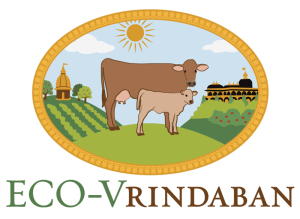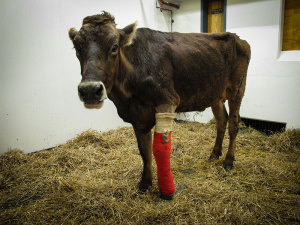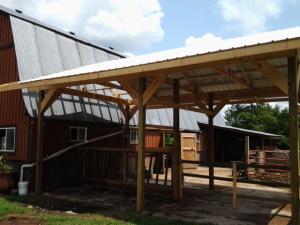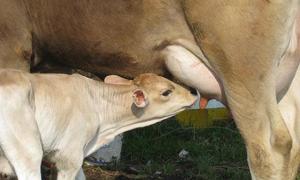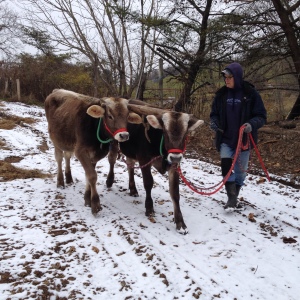New Vrindaban’s ECO-V Oversees Multiple Cow Protection Improvements in 2014
By Madhava Smullen
“Krishna by His practical example taught us to give all protection to the cows and that should be the main business of New Vrindaban,” Srila Prabhupada wrote to his disciple Hayagriva Das in 1968, leaving little doubt as to the community’s focus.
Since then, New Vrindaban has always protected cows. But this year, the Eco-Vrindaban organization – which looks after 640 acres of rolling green forests and pastures – has renewed its focus, overseeing multiple improvements in the quality of cow care.
To begin with, a higher budget and a larger number of experienced devotee staff have been assigned to the community’s 48 cows, calves and oxen. The team, consisting of longtime program overseer Ranaka, inspirational guide Varshana Swami, ox teamster Daivata, caretakers Radhanath and Ray, and milkers Anandavidya, Lalita Gopi, and Radhapriya meet every month.
One major step they’ve made this year has been to increase medical care, proven by the case of milking cow Shankari, who fell and broke her leg on the pasture in March.
In the world of commercial dairy farming, this would mean an instant death sentence. Shankari’s devotee caretakers, however, spent $10,000 to give her the best veterinary care available at the OSU veterinary hospital in Columbus, Ohio. There, she received an X-ray, surgery to fix the break, and a high-quality cast. Now, she’s walking again, healing in her own private pasture.
In April, older cows Bahula and Kalindi developed eye cancer and were brought to OSU for an operation to remove the infected eyes. Radhanath then washed their wounds daily and applied localized penicillin when Kalindi developed an infection. Since then, both cows have healed.
Besides immediate medical needs, ECO-V’s cow caretakers add other personal touches too. Head milker Anandavidya is doing a trial run on the product Fly Predator to rid the cows of bothersome flies. “The company sends you the larvae of a particular species of fly, which eats the larvae of the pest flies,” he says.
Meanwhile his wife Lalita Gopi has spent a lot of time cutting back the thorny wild rose bushes in the field next to the milking barn so that the cows don’t hurt themselves.
The milking cows can also look forward to a clean and cosy winter this year. Radhanath and carpenter Vyasasana Das have extended the feeding aisle in the milking barn to accommodate twice the number of cows, and created an enclosed “loafing area” where they can lie down in a clean, comfortable, hay-covered space.
There are also plans to create a new drainage system for the “hospital pasture” next to the milking barn where pregnant cows and calves are kept. This will prevent the cows from getting hoof rot, which can be extremely painful and is caused by too much time in mud.
The devotees caring for the cows also need to be cared for, and there are hopes to insulate the milking barn by this winter to keep the milkers warm.
“I was there last winter, and it’s brutal!” says part-time milker Radhapriya. “By the time you’ve finished milking it’s like you don’t have feet anymore. No matter how many socks or how many layers of clothes you wear, you just can’t stay warm!”
That hasn’t stopped the milkers from working hard. Anandavidya and Lalita Gopi are now milking nine cows – twice as many as last year – in the mornings and evenings. That means double the milk too, with an average of thirty gallons every day. In the afternoons, Anandavidya makes butter, yoghurt and panir from the milk, providing most of the dairy for the Deities, devotees and the community Govinda’s Restaurant during offpeak times.
The focus on cow protection at New Vrindaban has encouraged other devotees and guests to help with the cows too. Milking times are advertised as part of the temple schedule, so devotees occasionally come to milk, wash, feed or brush a cow. And South Indian brahmana Venkat Chalapati brings a group of guests nearly every morning for Go-puja and a chance to milk a cow.
“Lalita Gopi says that everyone should milk a cow at least once in their life,” Radhapriya enthuses. “And she’s right. When you spend time with cows, it automatically transports you into a relaxing, sattvic environment. You can go into the barn all stressed out, and being with the cows just makes it better. It slows you down – cows are not going to rush for anything!”
To add extra incentive for guests to visit, devotees have made the milking barn more attractive by painting Rangoli designs in the interior, and adding landscaping, freshly painted fences and a swing bench flanked by large, ornate flower pots to the exterior.
Of course, it’s not just the cows that are being cared for. Exciting developments are also afoot for oxen. Vyasasana Das is currently rebuilding an old barn in the Bahulaban area where the animals will be kept and trained separately from the main herd. The first floor will include spacious stalls for each ox and a tack room for equipment, while the second floor will be a hay loft. Outside there’ll be a training yard and holding area, with grazing pastures beyond.
Six bull calves between the ages of one month and one year – Pundarikaksha, Priya Darshan, Amani, Harichand, Nandi and Ishan – are already residing in Bahulaban and beginning their training to be oxen. Varshana Swami and Daivata Das, who worked with oxen in New Vrindaban’s early days, are leading the program.
The oxen are currently walking with a training yoke so that they get used to working together in pairs and learning commands. After that, they’ll start pulling a rope, then a chain and then a sled carrying firewood. Next, they’ll train for all the stages of breaking up soil until it’s fine enough to plant in – first plowing, then discing, and lastly harrowing.
Finally, when they’re two years old, the oxen will be ready to tackle the real precision work — pulling a cultivator between rows of crops. Varshana Swami hopes that they’ll make their first appearance at the community’s Garden of Seven Gates by next summer, and will be in serious production mode the summer after that.
Oxen, Varshana Swami feels, symbolize the kind of spiritual community Srila Prabhupada envisioned in New Vrindaban. “When you hitch two oxen together, the team dynamic kicks into play,” he says. “And Krishna is attracted where there’s teamwork, where there’s synergy, where there’s harmony, where everybody’s working together.”
“Which is,” he concludes, “What we here at New Vrindaban call the Brijbasi Spirit.”
